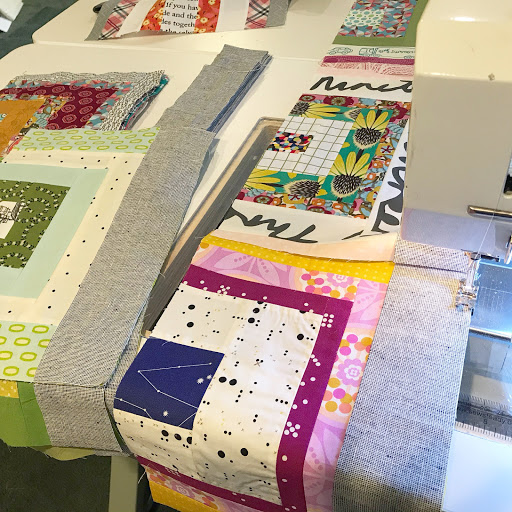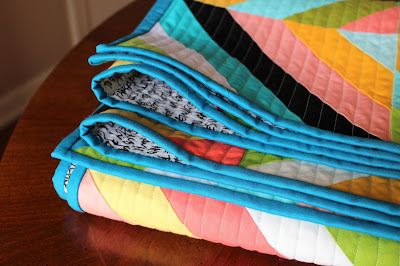I first spotted the Road Trip Redux Quilt on Instagram, and I was struck by the design's potential to be manipulated by fabric placement. Each version of the quilt looks quite different. The quilt pattern is by
Karen of Blooming Poppies and can be purchased through
her etsy shop. (FYI, this is not a paid promotion. I bought my pattern and am offering a review so you can avoid some of the challenges, mostly of my own making, which I encountered piecing the quilt).
This clever quilt design is comprised of three simple blocks: flying geese, half square triangles, and diamond in a square. Depending on fabric placement, the possible variations of the quilt are infinite, which is the greatest strength of the design, in my opinion. Keep in mind, you don't need to make changes. You could simply swap a new color for each one in the original, and make no further changes. But
if you do decide to do more than substitute fabrics for the ones used in the pattern, which of course I did, you will need to take a few additional steps.

It may be obvious, but changing the fabric placement in the design will mean you will need to calculate your own fabric requirements and cutting instructions. To do this you will need to do some quilt math and figure out how many of each block you will need for each fabric. This is where I made my mistakes! The pattern is written in such a way that each of the three blocks is pieced in a specific way, using only squares of fabric. For example, the flying geese block is made using a single large square which will become the goose and four smaller squares which will become the outside triangles. That single center square and four outside squares will make four flying geese blocks. SO, when you calculate how many flying geese blocks you will need to cut from a certain fabric, keep in mind the square for the goose will make four blocks, not one. This will help you avoid overcutting, like I did.

The pattern also includes instructions for the diamond in a square block, as well as the half square triangle blocks. The construction of these blocks use squares differently, so pay attention, again, before calculating how many squares to cut. The half square triangle blocks are made from
two squares of fabric to create
four triangles in two half square triangle blocks. The diamond in a square will use
four squares to make
four triangles on the outside of the block though. Just understand how each block is constructed before you do the quilt math, and you will be fine.
The pattern has several great features. It includes a blank coloring sheet of the design, so you can play around with fabric and color placement. I colored several versions before I settled on my design. This will allow you to mock up your quilt easily. The instructions also include nice illustrations for construction of the blocks, and there is little waste in the method. Another asset of the pattern is that it includes cutting dimensions to make the quilt in two sizes using the same instructions - a baby or throw size.
Check out the
hashtag #roadtripreduxquilt to see various versions of the quilt for inspiration. I'm waiting for backing to arrive so I get start finishing this cute baby size quilt.


















































